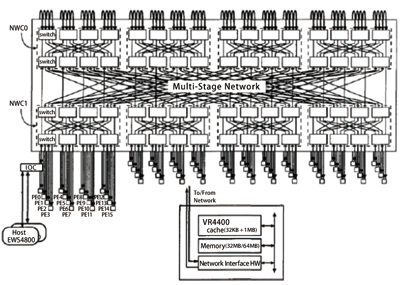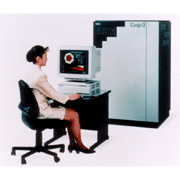The Cenju-3, announced in 1993, was NEC’s first distributed memory parallel computing system with multiple coupled microprocessors (VR4400). Since around 1985, NEC had been researching and developing the Cenju and the Cenju-II, which were parallel processing machines with multiple linked microprocessors that NEC intended to use for its own circuit simulations. Because of its success with parallelizing the finite element method and plasma simulations in addition to circuit simulations, NEC decided that the machines were suitable for a large range of applications. The end result was the commercialized Cenju-3 in 1993. Based on experiences with the Cenju and Cenju-II, the Cenju-3 could be utilized in configurations with as many as 256 coupled CPUs. A multistage interconnection network was adopted to ensure high-speed communications and a compact form factor while accommodating up to 256 CPUs. The Cenju-3 relied on the VR4400 microprocessor, which was capable of 150 MIPS or 50 megaFLOPS when used at a clock speed of 75 MHz, as its processing element (PE). Figure 1 illustrates the hardware architecture of the Cenju-3 (in a 64 PE configuration).

- Home >
- Historical Computers in Japan >
- Supercomputers >
- Cenju-3
【NEC】Cenju-3

The peak performance of the 256 PE configured system was 38.4 GIPS (150 MIPS x 256), or 12.8 gigaFLOPS (50 megaFLOPS x 256), and its maximum memory size was 16 gigabytes (64 megabytes x 256). NEC developed a custom hardware module for the processor-network interface on the Cenju-3 to improve communication speeds, the traditional bottleneck for parallel processing. This hardware interface lowered the software overhead by implementing, among other things, multiple communication modes (two messaging modes along with a DMA mode), automatic data segmenting, priority-ordered queuing, and various types of interrupts.
Cenju-3 was initially provided with Paralib/CJ, an NEC proprietary parallel library. Later, in around 1995, NEC’s C&C lab in Europe installed the Message Passing Interface (MPI), the industry’s standard parallel library, which improved the portability of programs. The Cenju-3 was used not only in Japan but also in Europe, mostly for research into parallel programming. And between 1994 and 1997, the machine was supplied as one of the platforms for the JSPP parallel programming contest, which was sponsored by the IPSJ.
 | ||
| A NEC Cenju-3 system in a 64 PE configuration |
All Rights Reserved, Copyright (C) Information Processing Society of Japan
